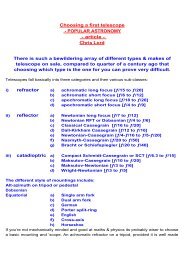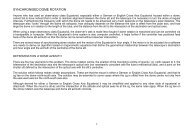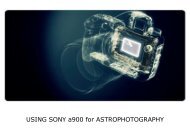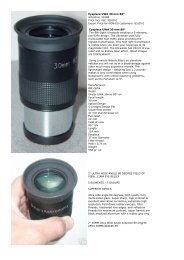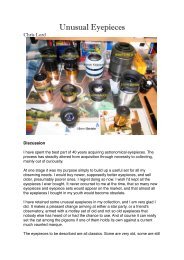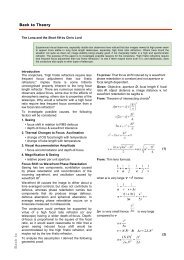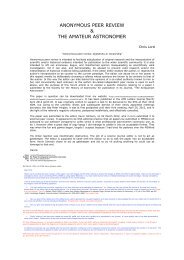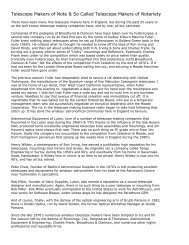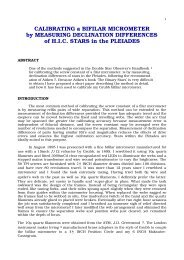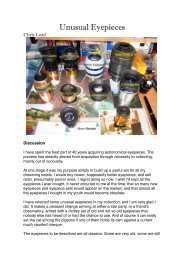Evolution of the Astronomical Eyepiece - Brayebrook Observatory
Evolution of the Astronomical Eyepiece - Brayebrook Observatory
Evolution of the Astronomical Eyepiece - Brayebrook Observatory
You also want an ePaper? Increase the reach of your titles
YUMPU automatically turns print PDFs into web optimized ePapers that Google loves.
EVOLUTION <strong>of</strong> <strong>the</strong> ASTRONOMICAL EYEPIECE<br />
TWO LENS EYEPIECES (cont.):<br />
HUYGHENIAN (cont.): Although lat -<br />
eral colour is corrected, <strong>the</strong> longitudinal<br />
aberrations are added, and this<br />
residual spherical and chromatic error,<br />
toge<strong>the</strong>r with coma and angular magnification<br />
distortion, become objectionable<br />
at focal ratios faster than f/12.<br />
The apparent field is about 40˚, but eye<br />
relief is less than 0.3Fe. Also <strong>the</strong> field<br />
stop lies between <strong>the</strong> field and eye<br />
lenses, and in high powers becomes<br />
fringed with false colour.<br />
RAMSDEN - <strong>the</strong> second two element<br />
design, devised by Jesse Ramsden <strong>the</strong><br />
London instrument maker in 1783. It<br />
consists <strong>of</strong> two plano-convex crown<br />
lenses <strong>of</strong> equal powers, <strong>the</strong>ir convex<br />
surfaces turned inwards. Ideally for<br />
lateral colour correction,<br />
where:<br />
d = 1 2( f 1<br />
+ f 2<br />
)<br />
Fe = d = ƒ 1<br />
However this brings <strong>the</strong> field stop into<br />
coincidence with <strong>the</strong> eye lens, hence<br />
zero eye relief, and every imperfection<br />
on <strong>the</strong> field lens is thrown into sharp<br />
focus. In pra cti ce <strong>the</strong>r e f o re d is<br />
reduced to between 0.8Fe and 0.6Fe,<br />
with increasing undercorrected lateral<br />
colour.<br />
RAMSDEN (cont.):<br />
The design is noted for its freedom from<br />
rectilinear distortion over a 35˚ apparent<br />
field, making it ideal for micrometers<br />
and finders, where cross wires are<br />
employed.<br />
A recent mo di fi ca tion usi ng fluorite<br />
lenses increases <strong>the</strong> apparent field to<br />
60˚ and reduces lateral colour.<br />
Spherical aberration, coma and longitudin<br />
al colour become objectionable<br />
below f/8.<br />
VARIANTS OF THE HUYGHENIAN:<br />
In 1812 Wollaston discovered that a<br />
meniscus-shaped lens produced less<br />
longitudinal spherical aberration and<br />
gave a flatter field than a simple planoconvex<br />
field lens. The Dutch optician<br />
Mittenzuuey used this to modify <strong>the</strong><br />
Huyghenian by incorporating a positive<br />
meniscus field lens and eye lens.<br />
Later <strong>the</strong> astronomer George Biddell<br />
Airy widened <strong>the</strong> apparent to 45˚ by<br />
introducing a bi-convex field lens.<br />
22



